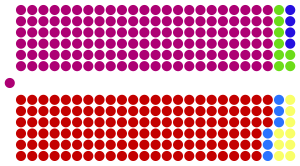1723 San Lucido Parliamentary Elections
| ||||||||||||||||||||||||||||||||
| ||||||||||||||||||||||||||||||||
| Turnout: 5,229,785,75 (85% of entitled) | ||||||||||||||||||||||||||||||||
The 1723 San Lucido Parliamentary Elections were the first elections held in the autonomous territory of San Lucido. They served to establish the composition of the Congresso di San Lucido for the first time.
The results saw the victory of the Unity Party, which obtained 46% of the preferences and 138 seats, while the Liberty Party obtained 45% and 135 seats.
Electoral Lists
| Name | Ideology | Leader |
|---|---|---|
| Unity Party | Social Democracy, Eco-socialism | Raphael Bullman |
| Liberty Party | Liberal conservatism, Liberalism | Rosamund Wesley |
| Justice Party | Right-wing populism, Regionalism | Augustus Rossether |
| People's Movement | Liberalism | Peter Verburgh |
| Green Party | Environmentalism, Progressivism | Grisel Gaskin |
| Partitu di Travagghiaturi | Labor Movement | Absalom Jefferies |
Electoral Campaign
The electoral campaign for the Congresso di San Lucido elections was a lively confrontation of ideologies and visions for the future of the country. The Unity Party, led by Raphael Bullman, has leveraged its platform of social democracy and eco-socialism, promising to implement policies aimed at social justice and environmental sustainability. With a message centered on equality and environmental protection, the Unity Party has sought to attract the attention of young voters and those concerned about climate change.
The Liberty Party, under the leadership of Rosamund Wesley, advocated a politics of liberal conservatism and liberalism, emphasizing individual liberty, free markets, and limited governance. Wesley aimed to consolidate support from moderate voters and businesses by proposing a vision in which innovation and economic growth go hand in hand with social responsibility.
The Justice Party, with Augustus Rossether at the helm, has adopted a position of right-wing populism and regionalism, seeking to capitalize on the discontent of some sectors of the population who feel neglected by the central government. Rossether promised to give a voice to the regions and fight for local rights and traditions.
Peter Verburgh's People's Movement presented a liberal platform, focusing on civil rights and the expansion of individual liberties. Verburgh aimed to build support among progressive voters who want a more inclusive and open government.
The Green Party, led by Grisel Gaskin, has put environmentalism and progressivism at the forefront, proposing aggressive policies to combat global warming and promote renewable energy. Gaskin has sought to appeal to voters who place the environment at the center of their political concerns.
Finally, the Partitu di Travagghiaturi of Absalom Jefferies represented the labor movement, fighting for workers' rights and for greater equity in the world of work. Jefferies appealed to the working class, promising to improve working conditions and raise the minimum wage.
The election campaign was characterized by lively public debate, exciting rallies and a series of televised debates in which party leaders had the opportunity to present their policies and engage directly with their opponents. Despite ideological differences, all parties shared the common goal of working for the well-being of San Lucido and its citizens. The competition was intense, but always respecting democratic rules and electoral ethics.
Results
| Party | Votes | % | Seats | |
|---|---|---|---|---|
| Unity Party | 2,405,701 | 46% | 138 | |
| Liberty Party | 2,353,404 | 45% | 135 | |
| Justice Party | 104,596 | 2% | 6 | |
| People's Movement | 156,894 | 3% | 9 | |
| Green Party | 130,745 | 2,5% | 8 | |
| Partitu di Travagghiaturi | 78,447 | 1,5% | 4 | |
| Total | 5,229,785,75 | 100% | 300 | |
Aftermath
The recent elections saw the Unity Party emerge as the most successful party, obtaining 46% of the vote. Despite this impressive result, the party failed to obtain an absolute majority, stopping at 138 seats out of a total of 300. The situation has left the country in a state of political uncertainty, with the Unity Party needing allies to obtain the majority in the Congresso.
In this context, the possibility of a coalition between the Unity Party, the **Green Party** and the People's Movement opened up. The Green Party, known for its commitment to environmental sustainability and green policies, won 8 seats, while the People's Movement, with its agenda focused on civil rights and liberalism, obtained 9 seats. If these parties decide to join the Unity Party, they could together achieve a majority of 155 seats, thus exceeding the necessary threshold of **151** for an absolute majority.
Such an alliance would lead to a coalition government with a variety of political perspectives. The Unity Party, could continue to push its agenda of social democracy and eco-socialism, while the Green Party could influence environmental policies and the People's Movement could ensure that civil rights remain a priority. This coalition could also face significant challenges, such as the need to find common ground between different ideologies and managing the expectations of their voters.
Forming a coalition government would require intense negotiations and compromises from all parties involved. However, if they could overcome these challenges, the new government could stabilize the country's political situation and work towards common goals for the good of the nation. The possibility of a coalition therefore represents a crucial moment for the country's political future, with the opportunity to lead the country towards a period of progressive reforms and sustainable growth.


